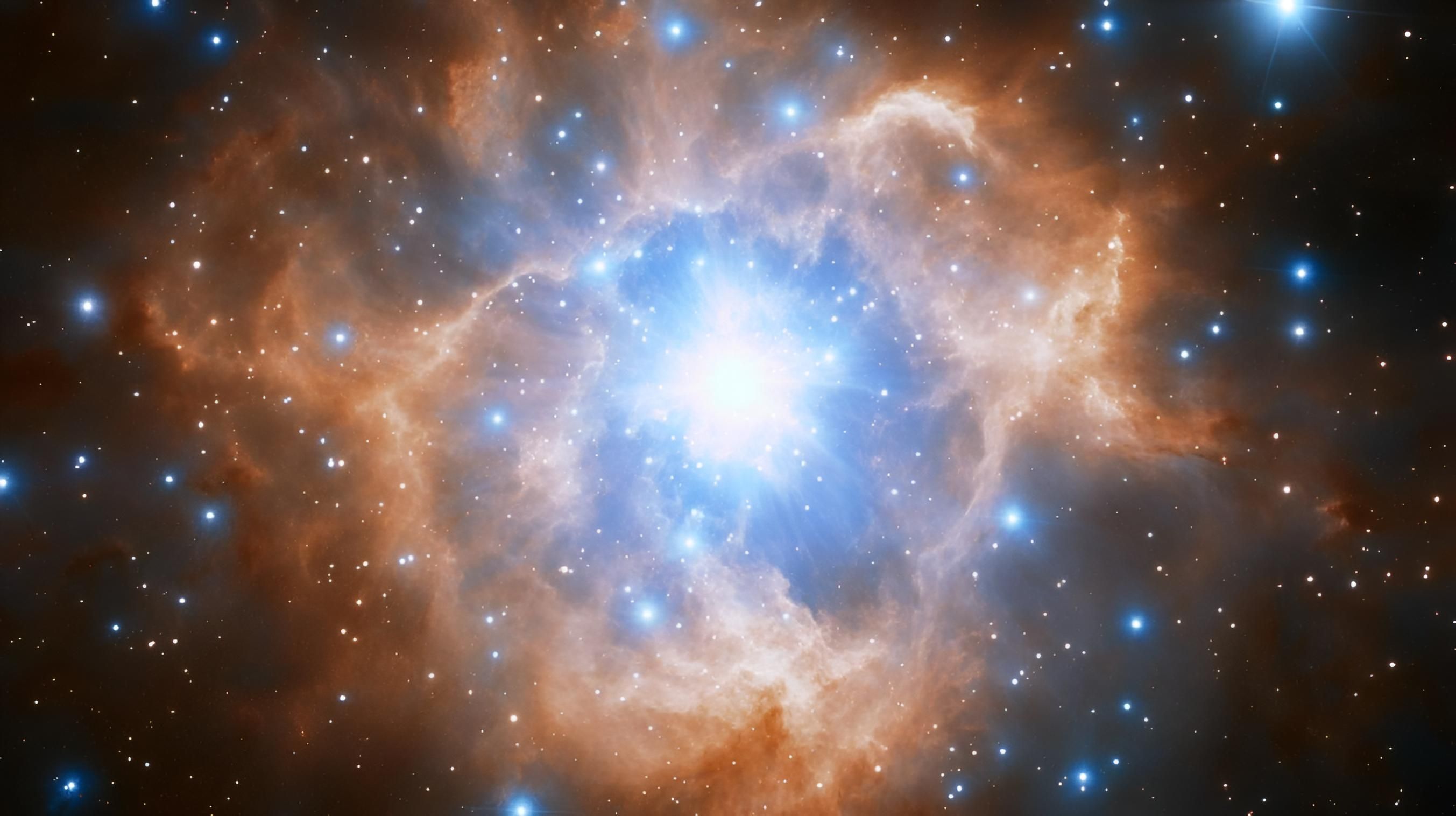I. Introduction: A New Cosmic Beacon
The universe, in its boundless expanse, holds an endless capacity for surprise. Just when humanity believes it has grasped the fundamental mechanics of cosmic phenomena, a new discovery emerges, challenging established paradigms and deepening the grand mystery. This inherent unpredictability is precisely what makes astrophysics such a thrilling frontier.
Astronomers have recently unveiled one such enigma: a celestial object designated ASKAP J1832-0911. This distant beacon, located approximately 15,000 light-years from Earth, exhibits an unprecedented characteristic: it emits powerful bursts of both radio waves and X-rays. What makes this discovery truly remarkable is the clockwork precision of its rhythm, pulsing every 44 minutes for a duration of two minutes. This dual-wavelength, precisely timed emission has never before been observed in this specific type of celestial event, immediately setting ASKAP J1832-0911 apart as a profound cosmic riddle.
This unique behavior signifies a major breakthrough in astrophysics. The very existence of ASKAP J1832-0911, with its dual-wavelength and precise periodicity, indicates a fundamental gap in our current astrophysical classification and emission models for transient objects. The combination of high-energy X-rays and coherent radio bursts, coupled with such a long and stable period, is not fully explained by any existing single theory, suggesting that the specific interplay of energy generation, magnetic field configurations, and rotational or orbital dynamics required for such a phenomenon is not adequately captured by current astrophysical frameworks. This compels astronomers to consider new mechanisms or object types, highlighting a significant void in our understanding of transient phenomena. Ultimately, ASKAP J1832-0911 challenges our current understanding of stellar behavior and the extreme physics governing compact objects, hinting at the possibility of new physical processes or previously unknown stages in stellar evolution, demanding a critical re-evaluation of established astrophysical models. It is not merely another flashing star; it is a cosmic anomaly that could unlock deeper secrets of the universe.
II. The Discovery: A Serendipitous Alignment
This groundbreaking discovery was a testament to the increasing power of international scientific collaboration and multi-wavelength astronomy. The initial detection was made by the ASKAP radio telescope in Western Australia, operated by Australia’s national science agency CSIRO, which picked up the regular radio signals. Crucially, at the same time, NASA’s Chandra X-ray Observatory was coincidentally observing the very same region of the sky.
This rare stroke of observational luck allowed astronomers to detect X-ray pulses that were perfectly synchronized with the radio flashes, a coincidence described by lead author Dr. Ziteng (Andy) Wang as “like finding a needle in a haystack” given Chandra’s comparatively narrower field of view. This simultaneous detection across different wavelengths was critical, as it allowed astronomers to definitively link both signals to the same mysterious object. The serendipitous, simultaneous detection across radio and X-ray wavelengths underscores the critical role of coordinated multi-messenger astronomy in uncovering truly novel astrophysical phenomena that might be missed by single-wavelength observations. If Chandra had not been observing that exact patch of sky at that exact moment, the crucial X-ray component, and thus the unprecedented nature of this Long-Period Transient, would have been entirely missed. This implies that current catalogs of cosmic objects are likely incomplete, not just due to instrumental sensitivity limits, but because crucial multi-wavelength signatures defining entirely new classes of objects or behaviors may be overlooked. This suggests a strategic shift in observational astronomy towards more systematic multi-wavelength campaigns to maximize the chances of capturing such rare, yet profoundly important, serendipitous overlaps.
ASKAP J1832-0911 has been classified as a Long-Period Transient (LPT). LPTs are a relatively new class of objects, first identified in 2022, characterized by their periodic bursts of radio energy over unusually long intervals, ranging from minutes to hours, far slower than typical pulsars that spin in milliseconds to seconds. While about ten LPTs have been found globally, ASKAP J1832-0911 stands alone as the first to also emit X-rays. This unique dual emission makes it an unparalleled member of this enigmatic family, providing an entirely new dimension to the study of these puzzling sources.
III. Decoding the Signals: What X-rays Reveal
The detection of X-rays from ASKAP J1832-0911 is a game-changer for understanding its nature. X-rays carry significantly more energy than radio waves; their presence implies that extremely robust and energetic physical processes are at work within or around the object, far beyond what might be inferred from radio emissions alone. This immediately rules out many less energetic astrophysical scenarios.
The dual signal, spanning such a wide energy range, provides a powerful new window into the “engines” that drive these cosmic metronomes. Any successful theory attempting to explain LPTs must now account for power across this broader energy range, pushing existing models to their theoretical limits and demanding a more comprehensive explanation for the underlying physics.
A particularly vital clue is that the radio and X-ray pulses occur in phase – meaning they align perfectly in time. This precise synchronicity is not a coincidence; it strongly suggests that both emissions are generated in the same region of the star’s magnetosphere or along the same magnetic field lines. This coordinated behavior points unequivocally toward a single, linked emission mechanism rather than two unrelated or spatially separated phenomena, providing a stringent constraint for any theoretical model. The precise synchronicity and inferred co-location of the radio and X-ray emissions from ASKAP J1832-0911 provide a critical and stringent constraint on theoretical models. Before this discovery, LPTs were only known in radio, and theoretical models did not need to account for simultaneous X-ray emissions or their precise synchronicity. This forces explanations to describe a single, unified, high-energy emission mechanism, rather than separate processes. This means the ultimate energy source and the conversion process must be capable of producing both high-energy X-rays and coherent radio bursts simultaneously and periodically from a single, compact region, significantly narrowing the field of plausible explanations.
IV. Leading Theories: Magnetars vs. White Dwarf Binaries
The Magnetar Hypothesis
One leading theory posits that ASKAP J1832-0911 could be a magnetar, a type of neutron star characterized by an extraordinarily powerful magnetic field – orders of magnitude stronger than typical neutron stars. Magnetars are renowned for their sporadic X-ray flares and bursts. A significant precedent for dual-wavelength emission came in 2020 when the first Fast Radio Burst (FRB 200428) detected within our Milky Way galaxy was definitively linked to a magnetar, SGR 1935+2154, which simultaneously exhibited an X-ray flare.
The fact that ASKAP J1832-0911 appears to lie within a supernova remnant, which often contains a neutron star formed by the supernova, lends some circumstantial support to this idea. If it is indeed a magnetar, data from Chandra suggests that its magnetic field might be undergoing twisting and snapping, a process known to accelerate particles to relativistic speeds, thus generating high-energy emissions.
Despite these intriguing alignments, existing magnetar models struggle to fully explain all of ASKAP J1832-0911’s observed properties. Specifically, older magnetars (those beyond 500,000 years), which might exhibit such long periods, are predicted to have much weaker magnetic fields and brighter quiescent X-ray emission than what has been observed from ASKAP J1832-0911. This makes the object’s bright and variable radio emission difficult to reconcile with a relatively old magnetar. Furthermore, the precise, clockwork stability of its 44-minute period is unusual compared to the often more erratic bursting behavior of known magnetars.
The White Dwarf Binary Hypothesis
An alternative theory proposes that ASKAP J1832-0911 could be a pair of stars in a binary system, where one of the components is a highly magnetized white dwarf (a dense, Earth-sized stellar remnant) interacting with a companion star. In such systems, X-rays can be generated as matter from the companion star crashes into the magnetic poles of the white dwarf. Some white dwarf optical pulsars, with similar long periods, have been observed in binary systems with red dwarf companions, and their emissions are believed to be powered by these binary interactions. This model could potentially account for the observed prolonged periodicity of ASKAP J1832-0911.
The primary hurdle for this hypothesis is the immense magnetic field strength required. To explain the observed luminosity and emission mechanisms, this scenario would necessitate the strongest magnetic field ever recorded for a white dwarf in our galaxy. Additionally, an isolated white dwarf cannot explain the observed data , and even with a companion, the specific emission mechanisms for such a hyper-magnetized white dwarf in a binary system still push existing theoretical frameworks to their limits.
The inability of even the most promising existing models (magnetars and white dwarf binaries) to fully explain all observed characteristics of ASKAP J1832-0911 indicates that the object might represent a new, exotic subclass of compact objects or a previously unobserved phase of stellar evolution. Dr. Wang explicitly states that these theories are “incomplete” and “do not fully explain what we are observing”. This collective inadequacy of the best existing models to fully encompass all observed characteristics (dual emission, precise long period, specific luminosities, and the observed long-term intensity drop-off) is a critical indicator. When established astrophysical frameworks cannot fully contain a new observation, it implies that the phenomenon lies outside the current boundaries of our understanding. This necessitates either a significant refinement of existing models to include an exotic subclass (e.g., a unique, hyper-magnetized white dwarf or a previously unobserved evolutionary state of a magnetar) or the conceptualization of an entirely new phase or type of compact object that has not been theorized before. This pushes the boundaries of theoretical astrophysics.
V. The Unanswered Questions: A Deepening Mystery
Despite the detailed observations and the exploration of leading theoretical explanations, the nature of ASKAP J1832-0911 remains a profound mystery. No single theory fully explains all the observed phenomena, particularly its unique combination of 44-minute radio and X-ray pulses, their precise synchronicity, and the observed long-term intensity drop-off over six months. As Dr. Wang aptly puts it, this object truly is “unlike anything we have seen before”.
The enduring mystery of ASKAP J1832-0911 carries profound implications for astrophysics. This discovery forces astronomers to rethink fundamental assumptions about the formation, evolution, and behavior of compact objects like neutron stars and white dwarfs. It challenges our understanding of the extreme magnetic fields and gravitational forces that govern these stellar remnants. The possibility looms that this object could point to entirely new physics or previously unknown stages in stellar evolution that are not yet accounted for in our astrophysical textbooks.
The rarity of Long-Period Transients (only about ten found globally since their initial discovery in 2022) and the fact that ASKAP J1832-0911 is the only one known to emit X-rays exacerbates the mystery. This rarity makes it harder to gather comparative data and build a robust statistical sample. However, it also strongly suggests that more such dual-signal objects might be “hiding in the cosmos” , waiting to be uncovered by future, more sensitive, and coordinated observations. The “unprecedented” and “unexplained” nature of ASKAP J1832-0911, coupled with the rarity of LPTs, suggests that humanity might be witnessing the tip of an iceberg for a new category of highly energetic, transient phenomena that are either extremely rare, short-lived, or difficult to detect with current observational strategies. The “needle in a haystack” analogy for the X-ray detection implies that many more such objects could exist but remain undetected due to observational biases, such as insufficient simultaneous multi-wavelength coverage or not observing long enough to capture these “long-period” events. This observation highlights a critical need for astronomers to adapt their search strategies, conducting more systematic, long-duration, and multi-wavelength surveys to fully map this emerging landscape of mysterious cosmic beacons.
VI. The Path Forward: Collaborative Astronomy
The discovery of ASKAP J1832-0911 vividly demonstrates the immense and growing value of combining observations across different wavelengths of the electromagnetic spectrum. As seen with ASKAP and Chandra, each part of the spectrum (radio, X-ray, and potentially others like infrared for contextual clues ) reveals different types of objects and processes. Their combined view is not merely additive; it is essential for constructing a truly holistic and comprehensive understanding of complex cosmic phenomena.
Astronomers are now racing to unravel the secrets of ASKAP J1832-0911. Future research will involve continued, more focused observations to gather additional data, refining its properties and behavior. Simultaneously, theoretical astrophysicists will work to develop new or significantly modified models that can fully account for its unique characteristics, particularly the dual-wavelength emission and precise long periodicity. A key objective will be to determine if LPTs, and specifically ASKAP J1832-0911, represent a new class of stellar remnants or something entirely unexpected. This will involve dedicated searches for more similar objects, especially those with dual-wavelength emissions, to build a larger statistical sample for comparative study and to constrain the population’s properties.
The ongoing mystery of ASKAP J1832-0911 serves as a powerful catalyst for interdisciplinary collaboration and the development of new theoretical frameworks in astrophysics, pushing the field beyond incremental advancements. When existing paradigms prove insufficient to explain a phenomenon, it necessitates fundamental conceptual shifts. This is not merely about tweaking existing models but potentially inventing new ones, or even new physics. This level of scientific challenge inherently fosters greater collaboration, as observational astronomers need theoretical insights to guide their searches, while theoretical astrophysicists need observational data to test and refine their models. Furthermore, the extreme conditions implied by the X-ray emissions might necessitate input from other fields, such as high-energy physics or plasma physics. This object acts as a “Rosetta Stone” for new physics or stellar evolution, driving the field forward in a non-linear fashion. The ongoing quest to unravel cosmic enigmas like ASKAP J1832-0911 is what makes science so thrilling and continuously expands our understanding of the universe we inhabit. By embracing these challenges through international collaboration and innovative observational techniques, humanity continues its journey of discovery, pushing the boundaries of knowledge and inspiring future generations to look up and wonder.





